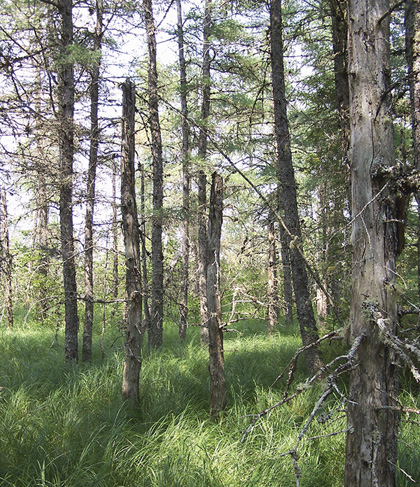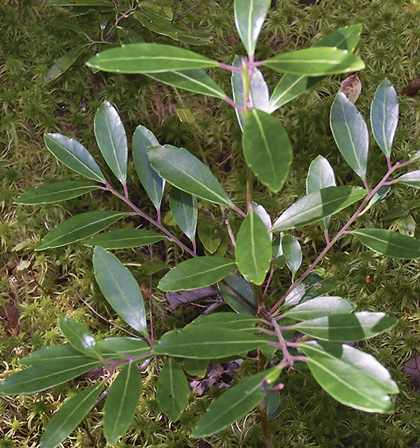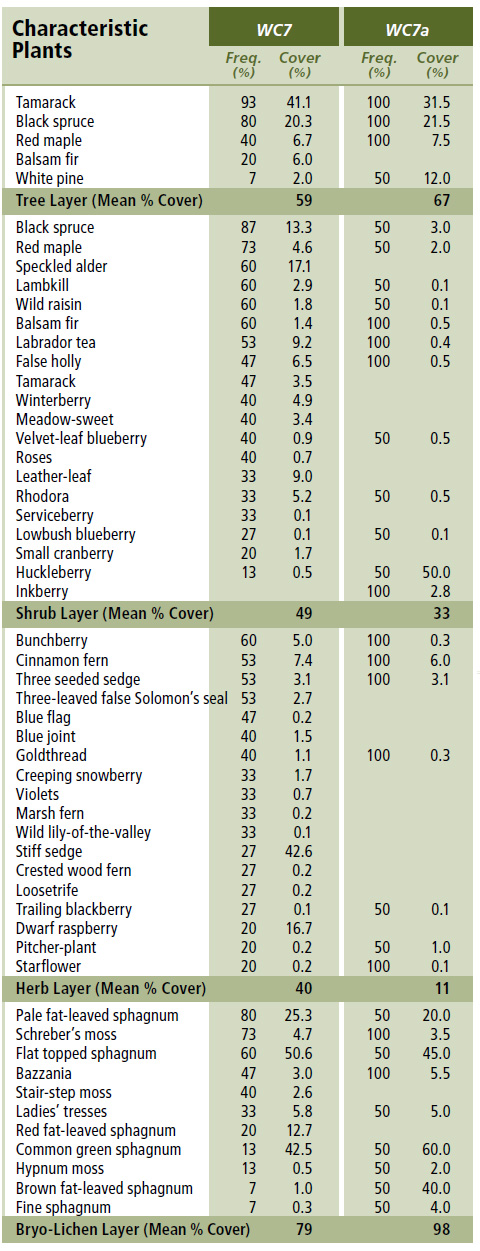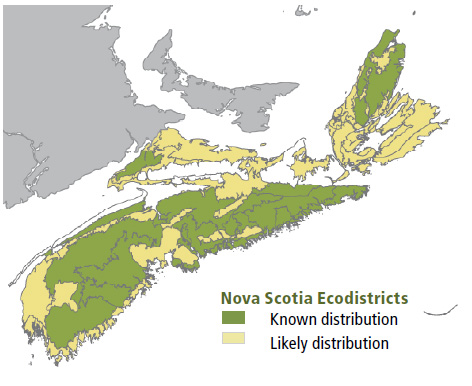
Forest Vegetation types - WC7
WC7 — Tamarack – Black spruce / Lambkill / Sphagnum
Larix laricina – Picea mariana / Kalmia angustifolia / Sphagnum spp.
WC7a — Huckleberry – Inkberry variant
Gaylussacia baccata – Ilex glabra
 |
| Otter Brook, Colchester County |
Concept: This wet coniferous forest is characterized by tamarack canopy dominance or co-dominance and high sphagnum cover. It is the only wet tamarack forest ecosystem classified from Nova Scotia. Stands with coastal plain species like inkberry and/or moderate to high levels of huckleberry distinguish the inkberry variant WC7a; most of these occur in the Western ecoregion. WC7 is common on poorly drained flats and depressions, with low to moderate nutrient availability.
Vegetation: Canopy layers are usually well developed but trees may be widely spaced and restricted to the tall shrub layer. Some stands have enough red maple to support mixedwood canopy structures. Prominent levels of larch characterize this typically coniferous ecosystem. Many stands are co-dominated by black spruce, while occurrences in western Nova Scotia may support scattered white pine. The understory is well developed but herb and shrub cover is variable. Generally, stands with high shrub cover support lower herbaceous cover and vice versa. Characteristic woody shrub species include lambkill and wild raisin. Few herbs are frequent, but three seeded sedge is often present. The dense bryophyte layer is largely dominated by pale fat-leaved sphagnum and flat topped sphagnum.
Environmental Setting: The Tamarack - Black Spruce / Sphagnum forest usually occurs on poorly to very poorly drained flats or shallow depressions. Most stands are supported by organic soil, derived from sphagnum moss, but gleyed or strongly mottled till (and, less commonly, lake or river deposits) are similarly typical. This ecosystem is occasionally expressed on moist mineral soil. Most sites have little if any microtopography and variable exposure. Occurrences are often at low elevation, but may be found up to 400 meters, or higher. Tamarack - Black spruce / Sphagnum forest is widespread and relatively common throughout the Maritime Provinces, but the WC7a variant is limited to Nova Scotia.
Successional Dynamics: This is an early to mid-successional ecosystem that may persist as an edaphic climax. It can follow stand-replacing timber harvest or severe windthrow, or succeed open wetland vegetation types in peatland successional sequences. Between disturbance events, natural senescence can create uneven-aged stands and promote increased black spruce cover. Higher relative soil fertility usually limits this Vegetation Type from fully transitioning to WC1 (Black spruce / Cinnamon fern / Sphagnum) or WC2 (Black spruce / Lambkill - Labrador tea / Sphagnum). However, on poorer sites WC7a may succeed to WC2a.
Ecological Features: This usually wet coniferous forest is our only tamarack on organic soils, representing an important component of landscape structure. It is relatively common, often found fringing open wetlands or developing after black spruce peatlands are disturbed by harvesting. The usually open canopy allows abundant light to the forest floor, promoting understory development and supporting wildlife that requires dense cover, moist soils and/or small pools or tracts of standing water. These include numerous bird, amphibian and invertebrate wildlife species. Documented rare plants include showy lady's slipper, black ash and alder-leafed buckthorn. Atlantic Coastal Plain species (e.g. Virginia chain fern, inkberry, catbrier, skunk cabbage and Elliot's goldenrod, among others) may be present in WC7a. Canadian occurrences of WC7a are limited to Nova Scotia, representing a particularly important element of provincial biodiversity.
 |
| Inkberry |
Distinguishing Features: Tamarack is diagnostic of this poorly drained softwood forest with variable levels of black spruce, red maple and speckled alder. The variant WC7a will have Coastal Plain species like inkberry and/or moderate to high levels of huckleberry. Sphagnum mosses are abundant with the three fat-leaved species common.
| Slope Position: | Level8 Depression2 |
Surface Stoniness: |
(Non - Slightly)9 nd1 |
Bedrock Outcrop: |
(Non-rocky)9 nd1 |
Elevation Range: |
8 - 415m |
Slope Gradient: |
Level10 |
Aspect: |
Level10 |
Exposure: |
Moderate6 Mod. sheltered2 Exposed1 Sheltered1 |
Microtopography: |
Level9 Other1 |
Drainage: |
Very poor6 Poor3 Imperfect1 |
Soil Type: |
ST146 ST41 ST61 ST71 ST101 |
Parent Material: |
Organic7 Lacustrine2 Other1 |
Rooting Depth (cm): |
(<30)7 (30-45)1 (>45)1 nd1 |
Duff Thickness (cm): |
(6-10)1 (21-40)2 (>40)5 nd1 |

